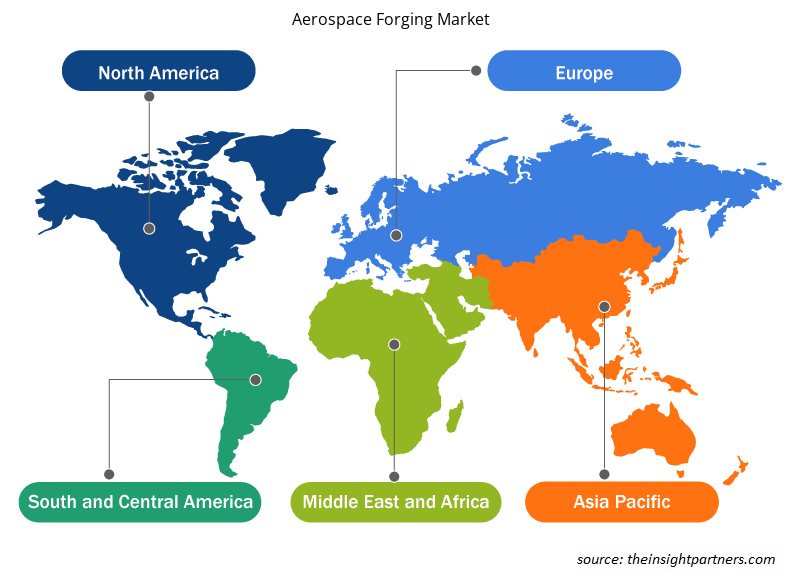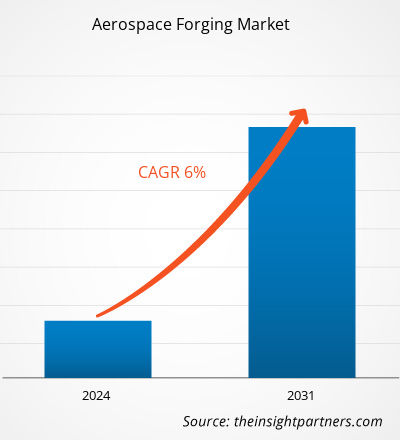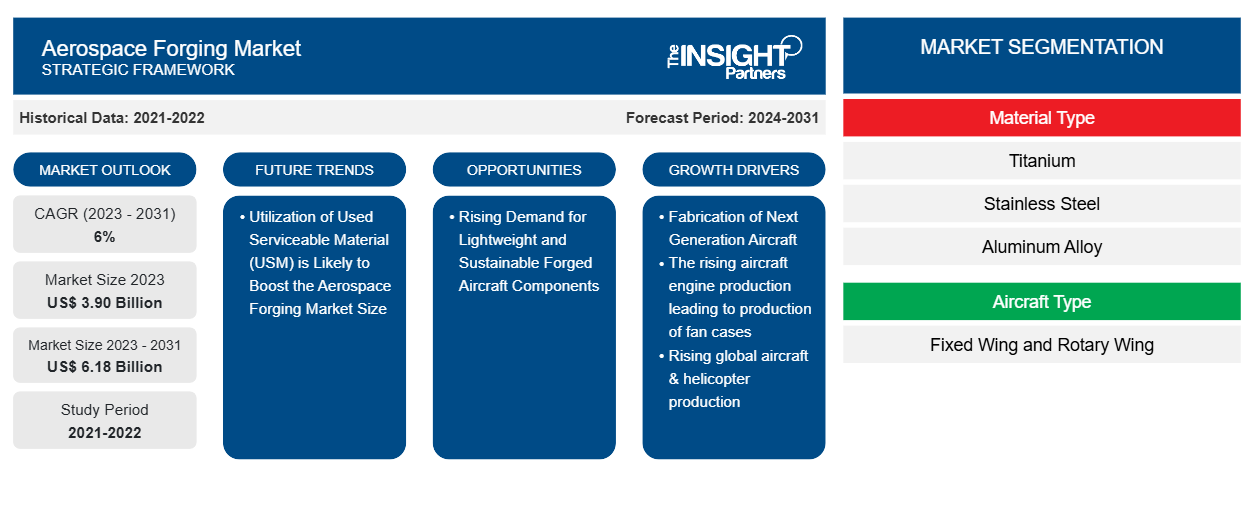La taille du marché du forgeage aérospatial devrait atteindre 6,18 milliards USD d'ici 2031, contre 3,90 milliards USD en 2023. Le marché devrait enregistrer un TCAC de 6,0 % en 2023-2031.CAGR of 6.0% in 2023–2031.
L'Amérique du Nord abrite plus de 40 % de la flotte mondiale d'hélicoptères et prévoit donc d'acheter et de remplacer la flotte existante par une nouvelle dans les prochaines années. Ce faisant, la région est en mesure de répondre aux exigences du marché de l'aérospatiale. Le remplacement des flottes existantes par de nouveaux hélicoptères stimulera également le marché de la forge aérospatiale en même temps. Certaines des entreprises impliquées dans la fabrication et la fourniture de moteurs d'avion et de produits de forgeage comprennent The Boeing Company, Patriot Forge Co., Scot Forge, United Technologies Corporation et d'autres.
Analyse du marché de la forge aérospatiale
Le marché du forgeage aéronautique devrait connaître une forte croissance au cours de la période 2023-2031. Cette demande de filtres aéronautiques est principalement motivée par la demande d'alliages d'aluminium et de titane pour la production de différents composants d'avions tels que les carters de soufflante, les disques de turbine et les rotors. En outre, l'augmentation du nombre de moteurs d'avion produits est un autre facteur majeur générant une nouvelle demande de pièces forgées aéronautiques à travers le monde.
Aperçu du marché de la forge aérospatiale
Le marché du forgeage aérospatial devrait connaître une croissance vigoureuse au cours de la période 2023-2031. La demande pour le marché du forgeage aérospatial est principalement motivée par certains des facteurs mentionnés ci-dessous :
- L'augmentation de la production de moteurs d'avion a conduit à la production de carters de ventilateurs
- La production mondiale d'avions et d'hélicoptères augmente
- Demande de MRO pour la flotte d'avions existanteMRO of existing aircraft fleet
- Augmentation de la production d'avions militaires
Ces facteurs sont susceptibles d'exprimer une croissance saine du marché du forgeage aérospatial. De plus, les États-Unis représentaient la plus grande part du marché mondial du forgeage aérospatial en 2023. Le pays est un fabricant leader d'équipements d'aviation générale tels que des petits avions, des hélicoptères et des jets d'affaires. L'industrie aérospatiale du pays a observé un changement dans les investissements manufacturiers. Le pays représente actuellement plus de 35 % de la production aéronautique mondiale. En outre, la présence de certains des principaux équipementiers aéronautiques, à savoir Boeing, Airbus, Bombardier et Textron Inc., a ses bases de fabrication établies aux États-Unis. Ces acteurs renommés soutiennent également l'activité de forgeage aérospatial, car le besoin de produits forgés pour l'aérospatiale augmente avec une augmentation de la production d'avions. Precision Metal Product Inc., Scot Forge, Fountaintown Forge, Pacific Forge Incorporated, Arconic Inc. et Mettis Aerospace Inc. sont quelques-uns des acteurs importants opérant sur le marché américain du forgeage aérospatial.
Personnalisez ce rapport en fonction de vos besoins
Vous bénéficierez d'une personnalisation gratuite de n'importe quel rapport, y compris de certaines parties de ce rapport, d'une analyse au niveau des pays, d'un pack de données Excel, ainsi que de superbes offres et réductions pour les start-ups et les universités.
- Obtenez les principales tendances clés du marché de ce rapport.Cet échantillon GRATUIT comprendra une analyse de données, allant des tendances du marché aux estimations et prévisions.
Facteurs moteurs et opportunités du marché de la forge aérospatiale
Fabrication d'avions de nouvelle génération
Dans l'industrie aéronautique commerciale, la production d'avions monocouloirs, de gros avions bicouloirs et de réacteurs de nouvelle génération devrait connaître un essor considérable. Les réacteurs de nouvelle génération utilisent des alliages de poudre métallique avancés et des superalliages à base de nickel. Il s'agit d'un modèle économique de l'avion, qui contribue à améliorer l'efficacité énergétique et les performances d'un avion. Par exemple, Airbus et Boeing ont reçu une commande pour la fabrication de plus de 40 000 avions. La production d'avions massifs de nouvelle génération augmentera à terme le marché des composants aéronautiques. De plus, la production d'avions de nouvelle génération devrait également offrir de vastes perspectives de croissance aux entreprises de forgeage de composants aéronautiques.
L'utilisation de matériaux usagés utilisables (USM) est susceptible de stimuler la taille du marché du forgeage aérospatial
Avec l'augmentation continue du trafic aérien, le nombre d'avions augmente considérablement pour répondre à la demande croissante des consommateurs. Cependant, près de 400 à 600 avions commerciaux dans le scénario actuel sont mis hors service, vieillissants et démontés chaque année, ce qui entraîne la création d'un tas de déchets. Cette quantité massive de déchets comprend environ 1 000 tonnes de fibre de carbone, 1 800 tonnes d'alliages, 30 000 tonnes d'aluminium et 600 tonnes d'autres matériaux de rebut. Dans le contexte de préoccupations croissantes concernant l'environnement, les entreprises aérospatiales telles que Pratt & Whitney ainsi que les organismes gouvernementaux ont identifié de nouvelles façons de remplacer les matières premières par des matières recyclées et renouvelables pour la fabrication de pièces aérospatiales.
Selon l'Organisation de l'aviation civile internationale (OACI), la durée de vie utile de près de 18 000 avions devrait prendre fin au cours des 10 à 15 prochaines années en raison de l'augmentation du trafic aérien. Par conséquent, l'utilisation de matériaux recyclés devrait offrir d'énormes opportunités aux entreprises de forgeage aéronautique. Par exemple, Boeing et Bharat Forge Ltd. ont manifesté leur intérêt pour entrer sur le marché de l'USM. De plus, dans les Amériques et en Europe, le secteur du recyclage offre d'énormes opportunités aux constructeurs aéronautiques et aux entreprises de forgeage aéronautique. Au contraire, chaque pays a ses conditions générales liées aux industries et à leurs activités. Par exemple, l'Europe a déjà rencontré des difficultés lorsqu'il s'agissait d'acheter ou de recycler du titane. Par conséquent, pour éradiquer cette situation, EcoTitanium est la première unité à recycler les alliages de titane de qualité aéronautique. Cette installation utilise des fours avancés pour recycler le titane, tout en réduisant les niveaux d'émission.
Analyse de segmentation du rapport sur le marché de la forge aérospatiale
Les segments clés qui ont contribué à l’élaboration de l’analyse du marché du forgeage aérospatial sont le type de matériau, le type d’avion, l’application et la géographie.
- En fonction du type de matériau, le marché du forgeage aérospatial a été segmenté en titane, acier inoxydable, alliage d'aluminium et autres. Le segment des alliages d'aluminium détenait une part de marché plus importante en 2023.
- Par type d'aéronef, le marché a été segmenté en aéronefs à voilure fixe et aéronefs à voilure tournante. Le segment des aéronefs à voilure fixe détenait la plus grande part du marché en 2023.
- En termes d'application, le marché a été segmenté en rotors, disques de turbine, arbres, carters de ventilateur et autres. Le segment des disques de turbine a dominé le marché en 2023.
Analyse des parts de marché du secteur de la forge aérospatiale par zone géographique
La portée géographique du rapport sur le marché du forgeage aérospatial est principalement divisée en cinq régions : Amérique du Nord, Europe, Asie-Pacifique, Moyen-Orient et Afrique et Amérique du Sud.
En 2023, la région la plus dominante sur le marché mondial du forgeage aérospatial était l'Amérique du Nord. Cela est dû au fait que la région est fortement concentrée en entreprises de forgeage aérospatial. La région abrite plusieurs constructeurs d'avions bien établis, des fabricants de moteurs d'avions et d'autres fabricants de composants d'avions. Ces fabricants d'avions/cellules et de composants d'avions demandent des produits forgés pour améliorer l'efficacité des moteurs, des trains d'atterrissage, des aérostructures et, en fin de compte, de l'avion dans son ensemble. En raison de cela, la région connaît une croissance de plusieurs acteurs, qui contribuent à des parts de revenus substantielles. Ces facteurs ont conduit la région nord-américaine à dominer le marché mondial du forgeage aérospatial.
Actualités et développements récents du marché de la forge aérospatiale
Le marché du forgeage aérospatial est évalué en collectant des données qualitatives et quantitatives après des recherches primaires et secondaires, qui comprennent des publications d'entreprise importantes, des données d'association et des bases de données. Voici une liste des développements sur le marché du forgeage aérospatial et des stratégies :
- En novembre 2023, Safran Aircraft Engines a signé un protocole d'accord avec Hindustan Aeronautics Limited pour développer une coopération industrielle dans la fabrication de pièces forgées pour moteurs d'avions commerciaux. (Source : Groupe Safran, Communiqué de presse/Site Internet/Newsletter)
- En février 2021, HAL et GE Aviation ont signé un contrat d'une valeur de 12 millions de dollars US pour le développement de pièces forgées annulaires, notamment des carénages, des carters, des bagues et des joints en acier et en nickel forgés. (Source : GE Aviation, communiqué de presse/site Web de l'entreprise/bulletin d'information)
Aperçu régional du marché de la forge aérospatiale
Les tendances et facteurs régionaux influençant le marché du forgeage aérospatial tout au long de la période de prévision ont été expliqués en détail par les analystes d’Insight Partners. Cette section traite également des segments et de la géographie du marché du forgeage aérospatial en Amérique du Nord, en Europe, en Asie-Pacifique, au Moyen-Orient et en Afrique, ainsi qu’en Amérique du Sud et en Amérique centrale.

- Obtenez les données régionales spécifiques au marché du forgeage aérospatial
Portée du rapport sur le marché de la forge aérospatiale
| Attribut de rapport | Détails |
|---|---|
| Taille du marché en 2023 | 3,90 milliards de dollars américains |
| Taille du marché d'ici 2031 | 6,18 milliards de dollars américains |
| Taux de croissance annuel composé mondial (2023-2031) | 6% |
| Données historiques | 2021-2022 |
| Période de prévision | 2024-2031 |
| Segments couverts | Par type de matériau
|
| Régions et pays couverts | Amérique du Nord
|
| Leaders du marché et profils d'entreprises clés |
|
Densité des acteurs du marché de la forge aéronautique : comprendre son impact sur la dynamique des entreprises
Le marché du forgeage aérospatial connaît une croissance rapide, tirée par la demande croissante des utilisateurs finaux en raison de facteurs tels que l'évolution des préférences des consommateurs, les avancées technologiques et une plus grande sensibilisation aux avantages du produit. À mesure que la demande augmente, les entreprises élargissent leurs offres, innovent pour répondre aux besoins des consommateurs et capitalisent sur les tendances émergentes, ce qui alimente davantage la croissance du marché.
La densité des acteurs du marché fait référence à la répartition des entreprises ou des sociétés opérant sur un marché ou un secteur particulier. Elle indique le nombre de concurrents (acteurs du marché) présents sur un marché donné par rapport à sa taille ou à sa valeur marchande totale.
Les principales entreprises opérant sur le marché du forgeage aérospatial sont :
- Arconic Inc
- Groupe Tous Métaux et Forges
- Bharat Forge Limitée
- Industries Consolidées, Inc.
- Groupe Farinia
- Fountaintown Forge, Inc
Avis de non-responsabilité : les sociétés répertoriées ci-dessus ne sont pas classées dans un ordre particulier.

- Obtenez un aperçu des principaux acteurs du marché de la forge aérospatiale
Rapport sur le marché de la forge aérospatiale : couverture et livrables
Le rapport « Taille et prévisions du marché de la forge aérospatiale (2021-2031) » fournit une analyse détaillée du marché couvrant les domaines ci-dessous :
- Taille du marché et prévisions aux niveaux mondial, régional et national pour tous les segments de marché clés couverts par le périmètre
- Dynamique du marché, comme les facteurs moteurs, les contraintes et les opportunités clés
- Principales tendances futures
- Analyse détaillée des cinq forces de Porter
- Analyse du marché mondial et régional couvrant les principales tendances du marché, les principaux acteurs, les réglementations et les développements récents du marché
- Analyse du paysage industriel et de la concurrence couvrant la concentration du marché, l'analyse de la carte thermique, les principaux acteurs et les développements récents
- Profils d'entreprise détaillés avec analyse SWOT
- Analyse historique (2 ans), année de base, prévision (7 ans) avec TCAC
- Analyse PEST et SWOT
- Taille du marché Valeur / Volume - Mondial, Régional, Pays
- Industrie et paysage concurrentiel
- Ensemble de données Excel
Rapports récents
Témoignages
Raison d'acheter
- Prise de décision éclairée
- Compréhension de la dynamique du marché
- Analyse concurrentielle
- Connaissances clients
- Prévisions de marché
- Atténuation des risques
- Planification stratégique
- Justification des investissements
- Identification des marchés émergents
- Amélioration des stratégies marketing
- Amélioration de l'efficacité opérationnelle
- Alignement sur les tendances réglementaires





















 Obtenez un échantillon gratuit pour - Marché de la forge aérospatiale
Obtenez un échantillon gratuit pour - Marché de la forge aérospatiale